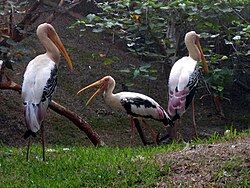| Indira Gandhi Zoological Park Vizag Zoo | |
|---|---|
 | |
| 17°46′09″N83°21′00″E / 17.7691°N 83.3500°E | |
| Date opened | 1977 |
| Location | Visakhapatnam, Andhra Pradesh, India |
| Land area | 625 acres (253 ha) |
| No. of animals | 850 |
| No. of species | 75 |
| Annual visitors | 10 million |
| Memberships | CZA, [1] WAZA [2] |
| Website | vizagzoo |





Indira Gandhi Zoological Park is located amidst Kambalakonda Reserve Forest in Visakhapatnam, Andhra Pradesh, India. It is the third largest zoo in the country. [3]
Contents
The zoological park is named after the former Prime Minister of India, Indira Gandhi. It was declared open to the public on 19 May 1977. [4] It covers an area of 625 acres (253 ha). It is situated in Visakhapatnam amidst the scenic Eastern Ghats of India. It is surrounded by the Eastern Ghats on three sides and Bay of Bengal on the fourth side. Nearly eighty species of animals numbering to about eight hundred are present in the zoo.
In collaboration with Stardust Ventures, Vizag zoo launched a web portal for animal adoption, to engage the community with latest events. It also allows general public to adopt an animal for certain time period. IGZP conducts various events regularly, like E-Webinars and Quizzes and also provides E-Certificates for the participants. The webinars are interactive sessions organized with various experts, and are streamed live over YouTube.
The zoo is about 11 kilometres (6.8 mi) from the Visakhapatnam railway station on the National Highway 5 near Yendada. It has entrance and exit gates situated oppositely, with one towards National Highway 5 and the other towards Beach Road at Sagar Nagar. It is open to public daily except Monday.
In February 2022, the zoo was received accreditation from the World Association or Zoos and Aquariums (WAZA) for coordinating a successful dhole breeding programme.

















